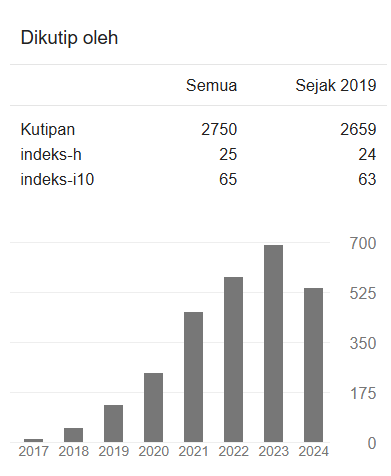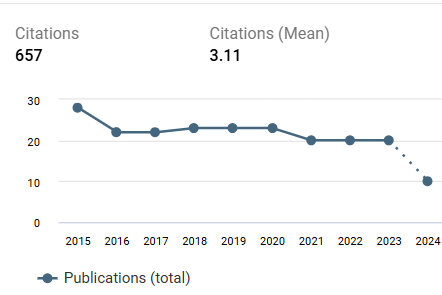Praktikum jarak jauh pada perkuliahan apresiasi menghias kain dengan video blog
DOI:
https://doi.org/10.22219/jinop.v7i2.17939Keywords:
Learning Media, Distance Practicum, Video blogAbstract
Online learning in Fashion Design Vocational School finds challenges in its application, especially in the practical learning method. One of the strategies used in practicum is by using video blogs in the process of delivering a practical lesson. This study aimed to find student perceptions in learning that utilizes online video blogs, the process of transmitting meaning on distance learning, and advantages and disadvantages of video blogs. There were 5 participants and 1 source person. The methods of data collection were conducted by doing interview, participatory observation, and documentation studies. The method employed in this study was a qualitative case study method conducted in the Decorating Cloth Appreciation class in the 2020/2021 Academic Year. The results showed that: (1) There were positive perceptions in online practicums related to teaching and learning aspects and the delivery of material with vlogs, negative perceptions were found on aspects of internet network limitations and student learning facilities during online learning. (2) The process of transmitting meaning was supported by instructional communication between educators and students. (3) The advantages of video blog media were in the aspect of delivering easy-to-understand content, the flexible and repetitive nature of the media user online. The lack of video blog media lies in the uneven understanding of students, especially in practicum cases which often lead to different findings in practice. It can be concluded that the use of video vlogs can be an alternative learning resource in distance practicum learning.
Downloads
References
Anwariningsih, S. H. (2011). Unsur Estetika Dalam Perancangan Media Pembelajaran Berbasis Karakter Untuk Mata Pelajaran TIK Siswa Sekolah Dasar (SD). Jurnal Gaung Informatika, 4(2).
Arifa, F. N. (2020). Tantangan Pelaksanaan Kebijakan Belajar Dari Rumah Dalam Masa Darurat Covid-19. Info Singkat; Kajian Singkat Terhadap Isu Aktual Dan Strategis, XII (7/I), 6.
Arnott, L., & Yelland, N. J. (2020). Multimodal lifeworlds: Pedagogies for play inquiries and explorations. Journal of Early Childhood Education Research, 9(1), 124–146.
Berk, R. A. (2009). Multimedia teaching with video clips: TV, movies, YouTube, and mtvU in the college classroom. International Journal of Technology in Teaching & Learning, 5(1).
Bungin, B. (2007). Penelitian kualitatif: komunikasi, ekonomi, kebijakan publik, dan ilmu sosial lainnya (Vol. 2). Kencana.
Daryanto. (2018). Media Pembelajaran. Gava Media.
Erniwati, E., Eso, R., & Rahmia, S. (2015). Penggunaan media praktikum berbasis video dalam pembelajaran IPA-Fisika untuk meningkatkan hasil belajar siswa pada materi pokok suhu dan perubahannya. Jurnal Sains Dan Pendidikan Fisika, 10(3).
Fajrin, M. (2011). Dinamika Gerakan Petani: Kemunculan Dan Kelangsungannya (Desa Banjaranyar Kecamatan Banjarsari Kabupaten Ciamis).
Hayati, N., & Harianto, F. (2017). Hubungan Penggunaan Media Pembelajaran Audio Visual dengan Minat Peserta Didik pada Pembelajaran Pendidikan Agama Islam di SMAN 1 Bangkinang Kota. Al-Hikmah: Jurnal Agama Dan Ilmu Pengetahuan, 14(2), 160–180.
Hwang, G.-J., Wang, S.-Y., & Lai, C.-L. (2021). Effects of a social regulation-based online learning framework on students’ learning achievements and behaviors in mathematics. Computers & Education, 160, 104031.
Iqbal, M., Latifah, S., & Irwandani, I. (2019). Pengembangan Video Blog (Vlog) Channel Youtube Dengan Pendekatan Stem Sebagai Media Alternatif Pembelajaran Daring. Inovasi Pembangunan: Jurnal Kelitbangan, 7(2), 135.
Korucu, A. T., & Alkan, A. (2011). Differences between m-learning (mobile learning) and e-learning, basic terminology and usage of m-learning in education. Procedia-Social and Behavioral Sciences, 15, 1925–1930.
Maulana, H. A., & Hamidi, M. (2020). Persepsi mahasiswa terhadap pembelajaran daring pada mata kuliah praktik di pendidikan vokasi. Equilibrium: Jurnal Pendidikan, 8(2), 224–231.
Miles, M.B & Huberman A.M. (1984). Analisis Data Kualitatif. Terjemahan oleh. Tjetjep Rohendi Rohidi. Penerbit Universitas Indonesia
Mu’minah, I. H. (2021). Pemanfaatan Media Pembelajaran Berbasis Video Sebagai Alternatif dalam Pembelajaran Daring IPA Pada Masa Pandemi Covid-19. Prosiding Penelitian Pendidikan dan Pengabdian 2021, 1(1), 1197–1211.
Munirah, M., & Budiyono, A. (2020). Pemanfaatan Media Video Blog (Vlog) Untuk Meningkatkan Keaktifan dalam Mendampingi Siswa Belajar di rumah. Seminar Nasional Hasil Pengabdian Kepada Masyarakat, 4(1), 306–311.
Nilamsari, N. (2014). Memahami studi dokumen dalam penelitian kualitatif. WACANA: Jurnal Ilmiah Ilmu Komunikasi, 13(2), 177–181.
Octavianti, M. (2016). Komunikasi nonverbal proksemik di rumah tidak layak huni. Jurnal Kajian Komunikasi, 4(1), 10–27.
Pane, A., & Dasopang, M. D. (2017). Belajar dan pembelajaran. Fitrah: Jurnal Kajian Ilmu-Ilmu Keislaman, 3(2), 333–352.
Preiss, R. W., & Wheeless, L. R. (2014). Perspectives on instructional communication’s historical path to the future. Communication Education, 63(4), 308–328.
Priana, R. Y. S. (2017). Pemanfaatan Vlog Sebagai Media Pembelajaran Teritegrasi Tekhnologi Informasi. Prosiding Seminar Nasional Pendidikan FKIP, 1(2).
Saldaña, J. (2021). The coding manual for qualitative researchers. Sage.
Saleh, A. M., & Handayani, S. (2020). Komunikasi Intruksional dalam Konteks Pendidikan: Pandangan Barat, Islam, dan Nusantara. Inteligensia Media (Kelompok Penerbit Intrans Publishing).
Sari, L. (2020). Upaya Menaikkan Kualitas Pendidikan dengan Pemanfaatan YouTube sebagai Media Ajar pada Masa Pandemi Covid-19. Jurnal Tawadhu, 4(1), 1074–1084.
Setiawan, T. Y., Arsil, A., & Noviyanti, S. (2021). Pemanfaatan Youtube Pada Sistem Pembelajaran Dalam Jaringan Masa Pandemi Covid-19 Di Kelas Iic Sekolah Dasar. Universitas Jambi.
Shintiyana, A. A. (2020). Komunikasi Instruksional Guru dalam Meningkatkan Keterampilan Sosial Anak Berkebutuhan Khusus di Sekolah Inklusif Galuh Handayani Surabaya. Commercium, 3(2), 1–11. https://ejournal.unesa.ac.id/index.php/Commercium/article/view/35773/31991
Sobron, A. N., & Bayu, R. (2019). Persepsi siswa dalam studi pengaruh daring learning terhadap minat belajar ipa. SCAFFOLDING: Jurnal Pendidikan Islam Dan Multikulturalisme, 1(2), 30–38.
Sugiyono, D. (2010). Metode Penelitian Pendidikan Pendekatan Kuantitatif, Kulaitatif dan R & D. Bandung: Cv. Alfa Beta.
Sugiyono, S. (2015). Metode penelitian kombinasi. Bandung: Alfabeta.
Thadi, R. (2019). Proses Komunikasi Instruksional dalam Pembelajaran Vokasional. JOEAI: Journal of Education and Instruction, 2(1), 49–55.
Utomo, A. Y., & Ratnawati, D. (2018). Pengembangan video tutorial dalam pembelajaran sistem pengapian di SMK. Jurnal Taman Vokasi, 6(1), 68–76.
Downloads
Published
How to Cite
Issue
Section
License
Copyright (c) 2021 Permata et al

This work is licensed under a Creative Commons Attribution 4.0 International License.
Copyright Notice
Authors who publish with JINoP (Jurnal Inoasi Pembelajaran) agree to the following terms:
- For all articles published in the JINoP (Jurnal Inovasi Pembelajaran), copyright is retained by the authors. Authors give permission to the publisher to announce the work with conditions. When the manuscript is accepted for publication, the authors agree to the automatic transfer of the publishing right to the publisher.
- Authors retain copyright and grant the journal the right of first publication with the work simultaneously licensed under a Creative Commons Attribution 4.0 International License. that allows others to share the work with an acknowledgment of the work's authorship and initial publication in this journal.
- Authors are able to enter into separate, additional contractual arrangements for the non-exclusive distribution of the journal's published version of the work (e.g., post it to an institutional repository or publish it in a book), with an acknowledgment of its initial publication in this journal.
- Authors are permitted and encouraged to post their work online (e.g., in institutional repositories or on their website) prior to and during the submission process, as it can lead to productive exchanges, as well as earlier and greater citation of published work (See The Effect of Open Access).








